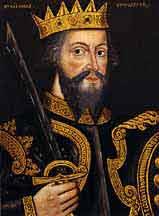Dyck, Sir Anthony van (1599-1641). Apart from Rubens, the greatest Flemish painter of the 17th century. In 1609 he began his apprenticeship with Hendrick van Balen in his native Antwerp and he was exceptionally precocious. Although he did not become a master in the painters' guild until 1618, there is evidence that he was working independently for some years before this, even though this was forbidden by guild regulations. Probably soon after graduating he entered Rubens's workshop. Strictly speaking he should not be called Rubens's pupil, as he was an accomplished painter when he went to work for him. Nevertheless the two years he spent with Rubens were decisive and Rubens's influence upon his painting is unmistakable, although ven Dyck's style was always less energetic.
In 1620 van Dyck went to London, where he spent a few months in the service of James I (1566-1625), then in 1621 to Italy, where he travelled a great deal, and toned down the Flemish robustness of his early pictures to create the refined and elegant style which remained characteristic of his work for the rest of his life. His great series of Baroque portraits of the Genoese aristocracy established the `immortal' type of nobleman, with proud mien and slender figure. The years 1628-32 were spent mainly at Antwerp.
From 1632 until his death he was in England -- except for visits to the Continent -- as painter to Charles I, from whom he received a knighthood. During these years he was occupied almost entirely with portraits. Perhaps the strongest evidence of his power as a portraitist is the fact that today we see Charles I and his court through van Dyck's eyes. It is customary to accuse van Dyck of invariably flattering his sitters, but not all his patrons would have agreed. When the Countess of Sussex saw the portrait (now lost) van Dyck painted of her she felt "very ill-favourede" and "quite out of love with myself, the face is so bige and so fate that it pleases me not at all. It lokes lyke on of the windes puffinge -- but truly I think tis lyke the originale."
Van Dyck's influence on English portraiture has been profound and lasting: Gainsborough, in particular, revered him, but he was an inspiration to many others until the early 20th century, when society portraiture ceased to be a major form of artistic expression. He also painted religious and mythological subjects, however, and a surprising facet of his activity is revealed by his landscapes in water-color (British Museum, London). His Iconography (1645) is a series of etchings or engravings of his famous contemporaries. Van Dyck etched some of the plates himself, and many more were engraved after his drawings and oil sketches.
Список литературы
Для подготовки данной работы были использованы материалы с сайта http://www.ibiblio.org/louvre/paint/
Похожие работы
... directions it rose to supreme highs. Russian painting The Tretyakov Gallery The state Tretyakov Gallery is one of the best-known art galleries in Russia. Different genres of painting are exhibited there. It takes its name from its founder Pavel Tretyakov, a Moscow merchant and connoisseur. In the middle of the XIX th century Pavel Tretyakov began to collect Russian paintings. A man of ...
... the aged housemaid Bridget Holmes. He was described by Horace Walpole as "one of the best native painters who have flourished in England". 4) Painting In The 18th Century. The eighteenth century was the great age of British painting. It was in this period that British art attained a distinct national character. In the seventeenth century, art in Britain had been dominated largely ...
... . Only since 1960 has the British Sovereign been featured on English bank notes, giving The Queen a unique distinction above her predecessors. STAMPS There is a close relationship between the British Monarchy and the postal system of the United Kingdom. Present-day postal services have their origins in royal methods of sending documents in previous centuries. Nowadays, the image of The ...
of promoting a morpheme is its repetition. Both root and affixational morphemes can be emphasized through repetition. Especially vividly it is observed in the repetition of affixational morphemes which normally carry the main weight of the structural and not of the denotational significance. When repeated, they come into the focus of attention and stress either their logical meaning (e.g. that of ...






0 комментариев